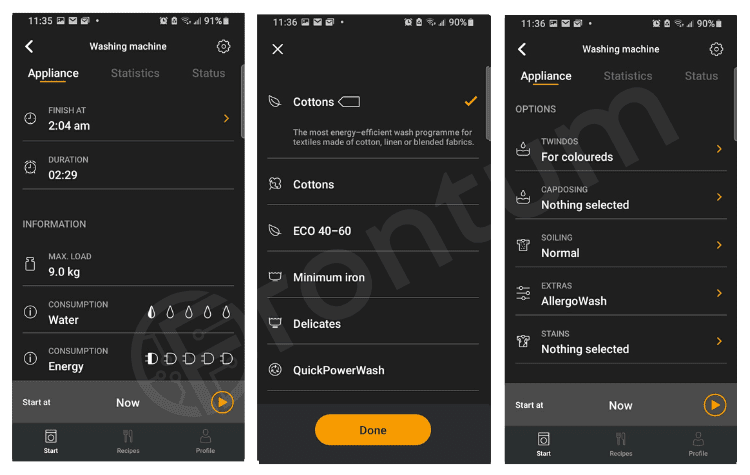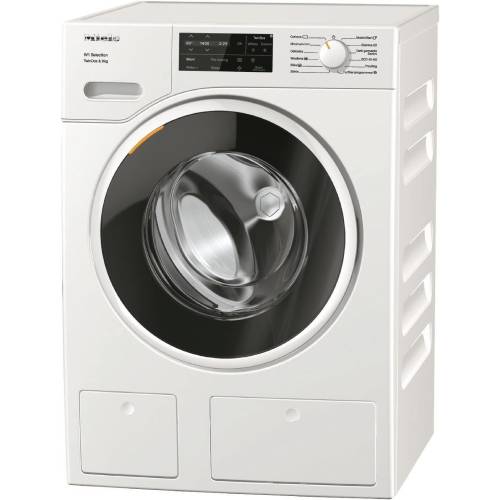Are Miele washing machines worth it?
Miele washing machines are certainly among the best on the market - they achieve an overall score of 7.8 points and rank #2 among the top washing machines. Miele also has a high user rating of 8.6, outperforming most other brands.
Without a doubt, Miele is one of the best washing machine brands. However, if you are looking for good alternatives, also consider models from Samsung, Siemens, Bosch, or LG.
The best washing machine brands are ranked based on their overall score as follows.
[horizontal-chart-39866564]
The top Miele washing machines (with the highest overall scores) are as follows.
- Miele WSI863 WCS W1 (Overall score: 8.47 points; Capacity: 9 kg)
- Miele WSG363 WCS (Overall score: 8.07 points; Capacity: 9 kg)
- Miele WSG663 WCS (Overall score: 7.88 points; Capacity: 9 kg)
What are the main advantages of Miele washing machines?
Miele washing machines offer the following advantages compared to other brands.
- Higher user ratings: Miele washing machines have an average user rating of 8.6 points, compared to the market average of 8.1 points.
- Larger capacity: Miele washing machines have an average capacity of 9 kg, while the market average is 8 kg.
- Lower energy consumption: Miele washing machines consume 49 kWh per 100 cycles, compared to the market average of 55 kWh.
- Quieter operation: Miele washing machines produce 69 dB of noise during spinning, compared to the market average of 75 dB, with an average noise emission class of A (compared to B for many other brands).
- Specialized wash cycles: Most Miele washing machines include specialized cycles such as Dark garments/Denim, Shirts, Outdoor, and Waterproofing, which are not commonly found in other brands.
- Advanced washing features: Miele washing machines include features like anti-crease function (rinse hold or pre-ironing with steam), quick function (Short), SingleWash (for small loads), allergy treatment, intensive wash, stain removal function, Water+, prewash, silent mode, and extra gentle function.
- Durable inverter motor: All Miele washing machines feature the ProfiEco motor, tested to last 20 years, ensuring efficient and cost-effective laundry care.
- Comprehensive features: Nearly all Miele washing machines include an automatic dosing system (TwinDos® or CapDosing), an AutoClean detergent drawer, self-cleaning function, automatic load recognition, water control system (WCS), load balancing system, foam control system, AddLoad function, energy-saving mode, EcoFeedback, and delay start option up to 24 hours.
- Special drum design: All Miele washing machines have a honeycomb drum, designed to protect delicate garments during washing.
- Wi-Fi connectivity: Most Miele washing machines are equipped with Wi-Fi connectivity via the Miele@mobile app.
What are the main disadvantages of Miele washing machines?
Miele washing machines have the following disadvantages compared to other brands.
- Higher cost: Miele washing machines cost nearly £800 more than the market average (£1,180 vs £380) and have a lower quality-price ratio (4.6 vs 7.1 points).
- Lower popularity: The average popularity of Miele washing machines is lower than the market average (5.4 vs 6 points).
- Shorter warranty: Miele washing machines come with only a 2-year motor warranty, whereas other brands typically offer warranties ranging from 5 to 10 years or more.
- Higher water consumption: Miele washing machines use slightly more water per cycle than the market average (48 L vs 46 L).
- No reduced spin speeds: None of the Miele washing machines offer a minimum spin speed of 400 revolutions per minute (whereas 67% of washing machines on the market do), making them less suitable for very delicate fabrics.
- Limited specialized cycles: Miele washing machines lack a Baby Care cycle, and very few models include a Duvets cycle.
- Missing advanced features: Miele washing machines do not include smart diagnosis, AI technology, or pre-mix technology, and only some models have a memory function.
Who manufactures Miele washing machines?
Miele washing machines are manufactured by Miele, a German company with a long history in the home appliance industry. Founded in 1899 by Carl Miele and Reinhard Zinkann in Herzebrock, North Rhine-Westphalia, Germany, Miele has grown to become a globally recognized brand for its high-quality products. The company remains family-owned, now in its fourth generation of management. This continuity in ownership allows Miele to maintain a consistent focus on quality and innovation, setting it apart from competitors.
Miele’s headquarters and main production facilities are located in Gütersloh, Germany. Here, the company produces not only washing machines but also a wide range of domestic and commercial appliances, including vacuum cleaners, dishwashers, and cooking equipment.
What are the different series of Miele washing machines?
Miele has only one series of washing machines, the W1 series. This series was released in 2013/14 and received an update in 2019. The W2 series has not yet been released.
What is the warranty period for Miele washing machines?
Miele washing machines come with a 2-year warranty covering both service and parts. While they do not include an extended warranty specifically for the motor, the ProfiEco motor is tested to last 20 years. Additionally, Miele offers a 20-year water protection warranty, covering the costs of material damage caused by defects in the water protection system, provided the appliance has been installed correctly.
How much do Miele washing machines cost?
Miele washing machines are priced between £650 and £1,250, with an average cost of approximately £1,180, making Miele the most expensive brand on the market. In comparison, the average price of a washing machine is around £380. Due to this high price, Miele ranks last in the quality-price ratio ranking, with an average of 4.6 points. If you are looking for a budget-friendly washing machine, consider other brands.
The chart below illustrates the price distribution among Miele washing machine models.
[vertical-chart-44185546]
The significant cost of Miele washing machines reflects their premium status but places them at a disadvantage when considering the quality-price ratio.
Note: The ranking excludes brands with fewer than 6 products in the database.
The most affordable Miele washing machines are as follows.
- Miele WSA003 WCS (~£650, 7 kg)
- Miele WSD123 WCS (~£780, 8 kg)
- Miele WSG363 WCS (~£1100, 9 kg)
What should you consider when choosing the best Miele washing machine?
To choose the best Miele washing machine, consider capacity, dimensions, energy consumption per 100 cycles, water consumption per cycle, spin-drying efficiency class, noise level during washing, inverter motor type, and the number of available washing programs.
What capacities are available for Miele washing machines?
Miele washing machines have capacities ranging from 7 to 9 kg, with 9 kg being the most common capacity (67% of models). For smaller loads, a 7 kg model is suitable, while larger families can opt for models with 8-9 kg capacities. Miele does not provide drum volume in its technical specifications.
The following chart illustrates the distribution of capacities among Miele washing machine models.
[pie-chart-21990438]
All Miele washing machines have a depth of approximately 63-64 cm, so no slim models are available. If you need a slim model, other brands may be more suitable. The width is around 60 cm, consistent with the market average.
How energy efficient are Miele washing machines?
Miele washing machines are highly energy efficient. 83% of Miele models are in energy class A, while the remaining 17% fall into class B. No Miele models are found in classes C-G. By comparison, around 39% of washing machines on the market belong to class A, 17% to class B, with the remainder distributed across lower classes. Miele stands out for energy efficiency compared to most other brands.
The energy efficiency of Miele washing machines is represented in the following chart.
[pie-chart-71559282]
Miele washing machines consume between 47 and 51 kWh per 100 cycles, with an average of 49 kWh, ranking second out of 22 brands for energy consumption. The market average is approximately 55 kWh per 100 cycles. Class A models consume less than 49 kWh per 100 cycles, while class B models remain below 55 kWh, with minimal variations based on capacity.
Miele washing machines consume 45 to 49 litres per cycle, with an average of 48 litres, placing them at position 16 out of 22 brands for water consumption.
What is the spin efficiency of Miele washing machines?
The spin efficiency of Miele washing machines is classified as either class A or B. Approximately 17% of models have class A spin efficiency, while 83% fall into class B. By comparison, class B is the most common in the market, covering 85% of washing machines, followed by class C (10%) and class A (5%).
The spin-drying efficiency class measures how much moisture remains in clothes after washing. It is a key indicator of how dry clothes will be after spinning and is closely related to the washing machine's maximum spin speed.
The distribution of spin efficiency classes among Miele washing machines is shown below.
[pie-chart-88466021]
The maximum spin speed of Miele washing machines ranges from 1400 to 1600 revolutions per minute (rpm). Most Miele washing machines (83%) have a maximum spin speed of 1400 rpm, while 17% reach 1600 rpm. These speeds surpass the market average, where only 4% of washing machines reach 1600 rpm, 60% reach 1400 rpm, and 22% reach 1200 rpm.
Regarding the impact of spin speed on residual moisture: at 1600 rpm, residual moisture is approximately 43%; at 1400 rpm, it is 50%; and at 1200 rpm, it is 53%. Higher speeds leave clothes drier, which is particularly useful for reducing drying times or optimising tumble dryer use.
Miele washing machines have a minimum spin speed of 600 rpm, so they do not reach the 400 rpm available in many models on the market (67% of washing machines can reach this speed). Lower spin speeds are ideal for protecting delicate fabrics. If you often wash delicate items, note that Miele washing machines may not be the best choice for these specific needs.
How noisy are Miele washing machines?
Miele washing machines have a spin noise level ranging from 68 dB to 72 dB, with an average of 69 dB, placing them in 2nd position in the noise level ranking out of 22 brands. Compared to the market average of 75 dB, Miele washing machines are significantly quieter. Since spinning is the loudest part of the washing cycle, this is a key measure for assessing overall noise levels.
All Miele washing machines are classified as noise emission class A (below 73 dB). In comparison, only 37% of all washing machines on the market belong to class A, while 35% are class B (73-76 dB), 26% are class C (77-80 dB), and 3% are class D (above 80 dB).
The distribution of spin noise levels among Miele washing machines is presented in the following chart.
[vertical-chart-27689224]
The washing noise level of Miele washing machines ranges from 47 dB to 50 dB, with an average of 48 dB. This is better than the market average of 53 dB. Although less significant than spin noise, the washing noise level can still impact the overall acoustic experience.
How many washing programs do Miele washing machines offer?
Miele washing machines have between 12 and 16 washing programs, similar to most other brands. The most common washing programs in Miele washing machines include: ECO 40-60, Cotton, Easy care, Wool, Delicates (for synthetic fabrics that retain their shape), Dark garments/Denim, Outdoor, Waterproofing (to restore water-repellent properties), Shirts (reduces creases and facilitates ironing), Silk, and Express 20.
The distribution of washing programs among Miele washing machines is illustrated in the following chart.
[vertical-chart-34951996]
Miele washing machines often include specialised cycles such as the Jeans cycle (found in all Miele washing machines, compared to 45% of other brands), the Shirts cycle (in 83% compared to 42%), and the Outdoor cycle (in 100% compared to 67%). Some advanced models also offer QuickPowerWash (completed in 49 minutes), Automatic Plus (for mixed laundry), Duvet, Hygiene Cotton, and Freshen-up. However, Miele lacks a Baby-care cycle (present in 39% of other brands), and only 17% of models include a Duvets cycle (compared to 46% of other brands).
The ECO cycle on Miele washing machines lasts between 199 and 219 minutes, with an average of 209 minutes, slightly shorter than the market average of 218 minutes. Typically, Miele washing machines include 1-2 quick cycles under an hour, such as Express 20 and QuickPowerWash, with the fastest cycle lasting 20 minutes.
Miele washing machines often include the following options to customise wash cycles based on your needs.
- Pre-ironing with steam (anti-crease function): reduces ironing by up to 50% by rolling laundry in a warm, damp drum with steam.
- Rinse hold: keeps laundry in water until you choose to proceed with spinning.
- Soak function: allows clothes to be soaked in water for an extended period before the main cycle.
- Intensive function: enhances washing mechanics and uses more energy to improve results on heavily soiled items.
- Stain removal option: lets you select up to three simultaneous stain types from 7 in basic models to 23 in higher-end models.
- Short (quick function): ideal for lightly soiled fabrics without visible stains.
- SingleWash: optimises time, water, and energy for very small loads (< 1 kg).
- Allergy treatment: high-hygiene washing with prolonged heat and intensive cleaning.
- Water+: increases water levels and rinsing during the washing cycle.
- Prewash: adds an extra washing phase for heavily soiled clothes.
- Silent function: reduces noise during the cycle.
- Extra gentle: minimises drum movement and washing time for delicate fabrics.
What are the common features of Miele washing machines?
Miele washing machines typically include 12 to 17 features, with an average of 15 (above the market average of 10 features).
The chart below illustrates how Miele washing machines vary by the number of features.
[vertical-chart-87289729]
The main features found in all or nearly all Miele washing machines include.
- TwinDos® system: automatic dosing with two detergent cartridges, UltraPhase 1 and UltraPhase 2, saving up to 30% detergent for 37 loads.
- CapDosing system (if not using TwinDos system): pre-dosed detergent or additive capsules, automatically dispensed at the optimal time.
- AutoClean detergent drawer (found in only 12% of other brands' models): removes detergent residue with water jets.
- Steam technology (found in only 58% of other brands' models)
- Automatic load recognition: adjusts water, energy, and time for lighter loads.
- Water Control System (WCS): monitors water intake via a sensor and stops it if problems or leaks are detected.
- Load balancing system
- Foam control system
- AddLoad function: allows users to add or remove laundry until the end of the wash cycle, even during rinse or spin phases.
- Delay start option (up to 24 hours)
- Energy-saving mode: available via the app, optimises energy use.
- EcoFeedback: provides precise information on energy and water consumption.
 Additionally, around 70% of Miele washing machines support Wi-Fi connectivity (via the Miele@mobile app), compared to 23% of other brands.
Additionally, around 70% of Miele washing machines support Wi-Fi connectivity (via the Miele@mobile app), compared to 23% of other brands.
The most advanced Miele models include features such as a memory function, a multilingual display for alerts and information, and PowerWash, which uses Spin & Spray technology with an additional water pump to recirculate water and detergent around the drum.

Miele washing machines use the ProfiEco motor, a powerful and quiet inverter motor, carbon brush-free, and tested to last 20 years. They feature a honeycomb drum, a special design with a hexagonal structure that creates a thin water film between the drum and laundry, protecting fabrics.
However, Miele washing machines do not include features such as smart diagnosis (found in 43% of other brands' washing machines), AI technology (11%), or pre-mix technology (24%). Additionally, no special anti-vibration design is mentioned in Miele models.
 Front-loading or top-loading: which Miele washing machine type is better?
Front-loading or top-loading: which Miele washing machine type is better?
Most Miele washing machines are front-loading. Very few top-loading models are available. If you prefer a top-loading washing machine, consider other brands.











